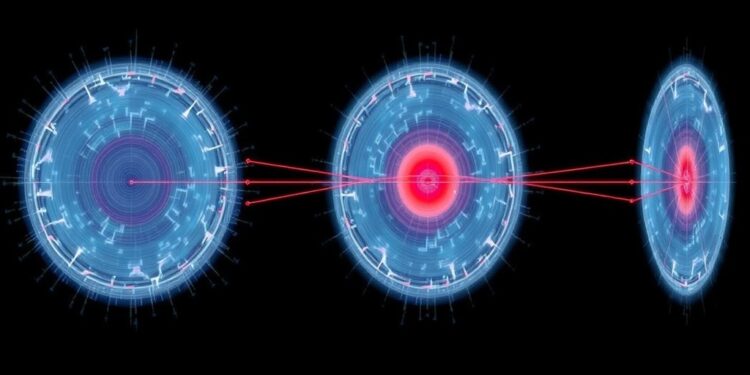
In an unprecedented advancement in the realm of attosecond science, researchers have successfully unveiled a novel method that allows the observation of ultrafast changes in material properties, with the potential to revolutionize future technologies. The ability to manipulate matter’s properties, such as switching it instantly from opaque to transparent or altering its conductivity, has long been a topic steeped in the allure of science fiction. Now, however, cutting-edge advancements led by a team at the Weizmann Institute of Science, under the guidance of Professor Nirit Dudovich, are bridging the gap between theoretical ambition and experimental reality.
The transformation of material properties using light is not merely a theoretical concept; it stems from the fundamental interactions between light and matter. Historically, it was believed that these interactions occur in a static manner, governed by the intrinsic properties of materials. However, recent investigations have illuminated a different narrative, revealing that powerful lasers can induce rapid alterations in how light is refracted as it traverses various materials. This indicates that refractive properties can be dynamically manipulated on time scales that were previously thought to be unattainable, facilitating a deeper understanding of fundamental physical processes.
In traditional optics, a common analogy to understand light refraction involves a rainbow, formed by sunlight interacting with raindrops. Each color within the sun’s spectrum slows down differently as it passes through water, leading to the familiar separation of colors. However, when researchers utilized high-intensity laser pulses, they posited that these refractive behaviors could be altered in real-time. By meticulously measuring the changes in delay as laser beams traversed materials, the team aimed to decipher the accelerative influences on light and matter interactions—insights that could harbor significant implications for ultrafast communications and data processing technologies.
Central to the study is the innovative technique of attosecond transient interferometry, which enables the researchers to effectively record the “journeys” that electrons take as they transition between varying energy levels within a material, altered by the influence of a laser. The proposed methodology involves the strategic use of dual laser beams: one long-pulse laser that instigates the intended adjustments in material properties and another emitting rapid attosecond pulses that capture the alterations in optical delay. This setup permits the precise reconstruction of how light behaves through these modified materials.
In a fascinating twist, the relationship between the electrons’ transitions and the changes in energy levels can be likened to navigation systems like Waze, which predict travel times based on varying routes. Researchers can now trace the delays experienced by electrons, offering them insights into how laser-induced changes affect energy levels. Initially, the methodology was applied to single atoms, with theoretical calculations demonstrating that the technique could extend its reach to more complex material systems, thus paving the path for extensive applications in the fields of computing and telecommunication.
The capability to track electron movements on such an incredibly short timescale—down to hundreds or dozens of attoseconds—could fundamentally alter how scientists approach the manipulation of materials within a quantum context. With refined control over a material’s properties, it becomes conceivable to craft the very fastest processors, significantly enhancing data transmission speeds and capabilities. Beyond technical advancements, this research holds the promise of unraveling new quantum phenomena that were previously elusive, contributing to a deeper understanding of quantum mechanics.
One of the pivotal aspects of the study is the technique’s potential implications for the realm of basic research. The ability to effectively capture real-time snapshots of electrons as they navigate the quantum landscape could unlock doors to myriad theoretical inquiries that have remained unanswered. As researchers continue to explore these phenomena, the intersection of light, matter, and quantum mechanics will undoubtedly provide fertile ground for futuristic innovations that enhance our technological foundations.
In the world of quantum physics, a material’s intrinsic properties are dictated by its energy levels, constructed similarly to a ladder. Under the influence of a potent laser, these levels can be modified, allowing for transitions that were previously inconceivable. Understanding these transitions not only enriches fundamental scientific knowledge but also serves as a cornerstone for advancements in the development of ultrafast computing devices.
The collaboration exemplified by this investigation features an impressive array of institutions, spanning globally recognized laboratories and universities. It highlights the synergistic nature of modern scientific endeavors, where interdisciplinary partnerships foster a rich environment for innovation. The involvement of researchers from institutions like the Max-Born-Institut in Berlin and MIT in Massachusetts once again underscores the significance of collaborative research in addressing complex scientific challenges.
As the findings continue to circulate within the scientific community, there is palpable anticipation surrounding the potential for practical applications of these discoveries. The implications for future technology developments are profound—enabling faster computers, advanced communication systems, and innovative quantum devices may very well redefine the parameters of innovation.
In conclusion, the research orchestrated by Prof. Dudovich’s team at the Weizmann Institute marks a pivotal moment in the field of attosecond science. Their ability to unveil real-time changes in material properties can transform our fundamental understanding of quantum mechanics and optics, unraveling the complexities of electron dynamics and ultimately leading to groundbreaking advancements in technology that could revolutionize nearly every aspect of our daily lives.
Subject of Research: Attosecond transient interferometry and its applications in manipulating material properties with lasers.
Article Title: Attosecond transient interferometry
News Publication Date: TBD
Web References: http://www.nature.com/articles/s41566-024-01556-2
References: DOI: 10.1038/s41566-024-01556-2
Image Credits: Noa Yaffe
Keywords
Tags: attosecond science advancementsdynamic refractive property manipulationexperimental advancements in opticsfundamental physical processes explorationfuture technology implicationslaser-induced material transformationLight-matter interactionsoptical manipulation techniquesProfessor Nirit Dudovichscience fiction technology realizationultrafast material property changesWeizmann Institute of Science research





